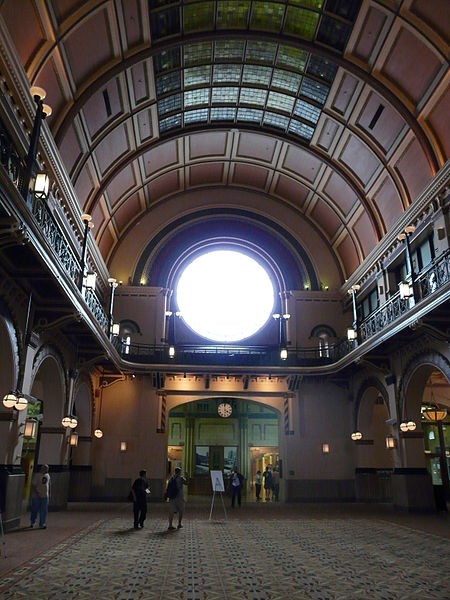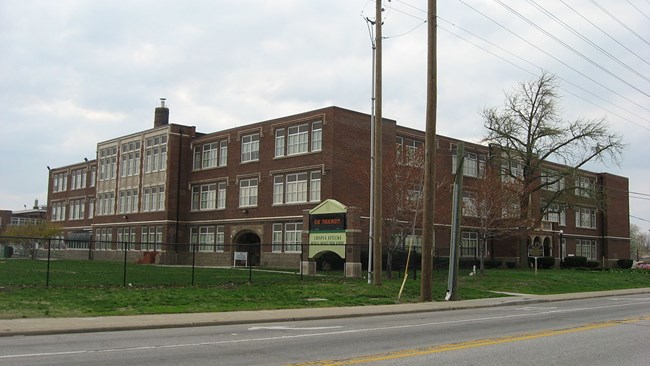Part of a series of articles titled Creative Teaching with Historic Places: Selections from CRM Vol 23 no 8 (2000).
Article
The Community as Classroom

https://commons.wikimedia.org/wiki/File:Union_Station_-_Ind_01b.JPG
Published by the National Park Service, Cultural Resources
by Bill Gulde
North Central High School is located in the heart of the northern suburban neighborhoods of Marion County, outside Indianapolis, Indiana. Although annexed by the city in 1970, Washington Township has a built environment largely reflective of the post-war building boom of the 1950s and 1960s. Students live in sprawling ranch style homes that sit on large lots or in apartment complexes with names like “Turtle Creek” or “North Willow Farm.” They shop at two nearby malls built in the 1970s and 1980s and eat in national chain restaurants along busy thoroughfares. Many students in our fine institution have been all over the country and all over the world, but know little about the history of the looming city to the south of them. It was for this reason that I went on my own personal crusade to educate students about the wonderfully rich architectural heritage in their own backyard.
With the assistance of Historic Landmarks Foundation of Indiana, I designed a unit that would take students out of my history class and into the classroom of the city. Indianapolis is a perfect laboratory for above-ground archaeological research with its many historic schools, churches, temples, homes, parks, cemeteries, libraries, factories, hospitals, and commercial buildings. Suzanne Stanis, the education coordinator for Historic Landmarks, served as a consultant for my classes, and her help with this project was invaluable. She spent many minutes of her life on the phone with inquiring students, some of whom called her at the last hour. I also lined up many people in the community to serve as resources for the project.
I divided the students into teams of three. They were given a long list of historic sites from which to choose. Many of the sites were listed in the National Register of Historic Places so pupils could make use of our local state preservation office for additional material. It was important that each team have three members as they really had to focus their research on a particular site from a local, state, and national angle. Students researching historic Union Station (1887), the main railway terminal for Indianapolis, would not only examine the history of the building and the site, but they would also be responsible for grasping the importance of rail traffic in Indiana and the nation. As part of the assignment, each team was required to visit its site and interview an expert so students could place the building within a historical context. The culmination of their work would be a public presentation in which parents, members of the community, the faculty, and students would be invited to attend.
Before allowing teams to choose a site, I gave the class a brief history of the built environment of the city. I shared my own personal collection of historic postcards and photographs of Indianapolis. Several students noted that some of those buildings were actually on their list. In order to be fair, I asked students to choose their top three favorites from my list and then we had a lottery as several teams vied for some of the same sites. The Pathology Building (1895) on the grounds of the former Central State Mental Hospital proved to be very popular when students discovered that turn-of-the-century doctors performed autopsies on deceased mental patients. Interest peaked when they learned that the brains floating in jars of formaldehyde still rest on the laboratory shelves. Crown Hill Cemetery (1863), with its Arcadian winding paths, high hills, Victorian tombstones, and famous former residents enchanted several students. Still others sought out sites associated with the city’s automobile age, including the Stutz Auto Company (1914) factory building and the Indianapolis Motor Speedway (1908). I guided one group particularly interested in historic homes to the Woodruff Place neighborhood, an 1870s suburb of the city, now almost considered “downtown.” These three students had lived their entire lives in Marion County, but had never seen this wonderful Victorian neighborhood with its esplanades, gushing fountains, tall trees, sculptures, and beautifully painted historic homes.
Students took great ownership in their project and many truly prided themselves on their newly found expertise. Pupils researching Crispus Attucks High School (1927), now a middle school, discovered that the building was constructed in the 1920s on the orders of a school board highly influenced by the most powerful organization to dominate the state in that decade, the Ku Klux Klan. The all Black high school would later serve as a source of pride for the Black community as several of the teachers on the faculty had doctorates. My kids marveled at the quality of teachers and the number of prominent graduates.

https://en.wikipedia.org/wiki/File:Crispus_Attucks_High_School.jpg
After countless hours in local libraries and museums, students prepared for their presentations. Knowing that many “outsiders” had been invited placed additional pressure upon them. I reserved a wonderful lecture room in our school that contains numerous pieces of technology. Students had the option of presenting their findings in any form. One team did an impressive Power Point demonstration on the history of the James Allison mansion (1910) while another group dressed in the costumes of railroad conductors, carried lanterns, and produced a skit on Union Station. Every team had to have several visuals so students took photos, slides, videos, and purchased post cards.
Evaluations from students on the project seemed to validate what I was trying to accomplish. There are some roadblocks and difficulties with the project, however. Finding time to squeeze a significant unit like this into an already crowded curriculum can be daunting. Furthermore, in this day and age of accountability many teachers are putting aside creative projects, fearing that students will not do well on state-mandated tests. I maintain that it is worth the time to create projects that make history more meaningful and allow students to become experts on narrow historical topics. Pupils who researched the Broad Ripple Post Office (c. 1925) documented a Depression-era mural and when it came time to discuss the New Deal, I can tell you that I turned over the discussion of the WPA to these three students. Keeping in mind that it is our job as educators to make history come alive, I encourage teachers to utilize the community as the classroom. Students will find meaning in local history and if we have succeeded then these young people will look at the built environment around them in an entirely different way.
At the time of publication, Bill Gulde taught US, world, and European history at North Central High School, Indianapolis, Indiana, and had served as a Social Studies Department Chair for four years.
Last updated: July 1, 2019
